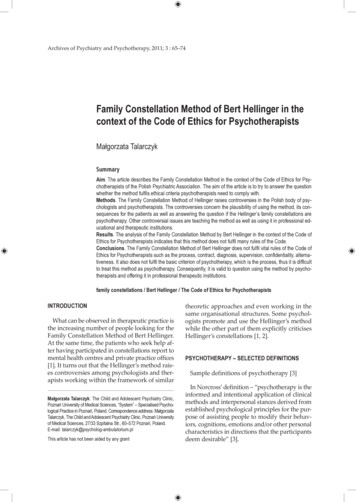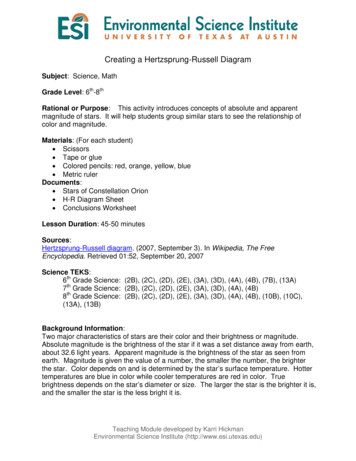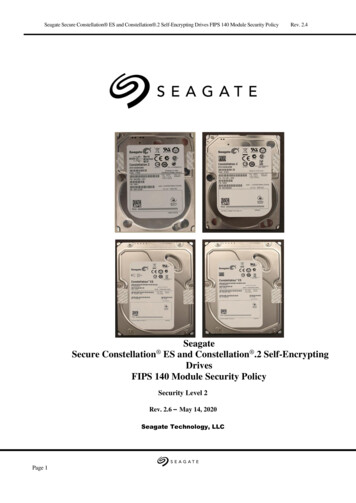
Transcription
Seagate Secure Constellation ES and Constellation .2 Self-Encrypting Drives FIPS 140 Module Security PolicyRev. 2.4SeagateSecure Constellation ES and Constellation .2 Self-EncryptingDrivesFIPS 140 Module Security PolicySecurity Level 2Rev. 2.6 – May 14, 2020Seagate Technology, LLCPage 1
Seagate Secure Constellation ES and Constellation .2 Self-Encrypting Drives FIPS 140 Module Security PolicyRev. 2.4Table of Contents12345678Introduction. 31.1Scope. 31.2Security Levels . 31.3References . 31.4Acronyms . 3Cryptographic Module Description . 52.1Overview. 52.2Logical to Physical Port Mapping . 52.3Product Versions . 62.4FIPS Approved Algorithms . 72.5Self-Tests . 72.6FIPS 140 Approved Modes of Operation. 72.6.1TCG Security Mode . 82.6.2ATA Enhanced Security Mode . 82.6.3Entering FIPS Approved Modes of Operation . 82.7User Data Cryptographic Erase/Sanitize Methods . 82.8RevertSP Method . 82.9Show Status. 8Identification and Authentication (I&A) Policy . 103.1Operator Roles . 103.1.1Crypto Officer Roles . 103.1.2User Roles . 103.1.3Unauthenticated Role . 103.2Authentication . 103.2.1Authentication Types . 103.2.2Authentication in ATA Enhanced Security Mode . 113.2.3Authentication in TCG Security Mode . 113.2.4Authentication Mechanism, Data and Strength. 113.2.5Personalizing Authentication Data . 11Access Control Policy . 124.1Services . 124.2Cryptographic Keys and CSPs . 154.3Non-Critical Security Parameters . 17Physical Security . 175.1Mechanisms . 175.2Operator Requirements . 18Operational Environment . 20Security Rules . 207.1Secure Initialization . 207.2Ongoing Policy Restrictions . 20Mitigation of Other Attacks Policy . 20Page 2
Seagate Secure Constellation ES and Constellation .2 Self-Encrypting Drives FIPS 140 Module Security PolicyRev. 2.41 Introduction1.1 ScopeThis security policy applies to the FIPS 140-2 Cryptographic Module (CM) embedded in Seagate Constellation ES and Constellation .2 Self-Encrypting Drives.This document meets the requirements of the FIPS 140-2 standard (Appendix C) and Implementation Guidance(section 14.1). It does not provide interface details needed to develop a compliant application.This document is non-proprietary and may be reproduced in its original entirety.1.2 Security LevelsFIPS 140-2 Requirement AreasSecurity LevelCryptographic Module SpecificationCryptographic Module Ports and InterfacesRoles, Services and AuthenticationFinite State ModelPhysical SecurityOperational EnvironmentCryptographic Key ManagementElectromagnetic Interface / Electromagnetic Compatibility (EMI / EMC)Self – testsDesign AssuranceMitigation of Other Attacks22222N/A2322N/AThe overall security level pursued for the cryptographic modules is Security Level 2.1.3 References1.2.3.4.FIPS PUB 140-2Derived Test Requirements for FIPS PUB 140-2Implementation Guidance for FIPS PUB 140-2 and the Cryptographic Module Validation ProgramTCG Storage Security Subsystem Class: Enterprise, Specification Version 1.0, Revision 2.0, December 21,20095. TCG Storage Architecture Core Specification, Specification Version 1.0, Revision 0.9, May 24, 20076. TCG Storage Interface Interactions Specification, Specification Version 1.0,7. ATA-8 ACS8. Serial ATA Rev 2.6 (SATA)9. SCSI Primary Commands-4 Rev 15 (SPC-4)10. SCSI Block Commands Rev15 (SBC-3)11. Serial Attached SCSI-2 Rev 13 (SAS-2)1.4 AcronymsAESCBCCMCOCSPDRBGMEKFIPS 140HDAHDDIVPage 3Advanced Encryption Standard (FIPS 197)Cipher Block Chaining, an operational mode of AESCryptographic ModuleCrypto-officerCritical Security ParameterDeterministic Random Bit GeneratorMedia Encryption KeyFIPS 140-2Head and Disk AssemblyHard Disk DriveInitialization Vector for encryption operation
Seagate Secure Constellation ES and Constellation .2 Self-Encrypting Drives FIPS 140 Module Security PolicyLBAMSIDPNPORPOSTPSIDRNGSIDSoCSPPage 4Rev. 2.4Logical Block AddressManufactured SID, public drive-unique value that is used as default PIN, TCG termPart Number(s)Power-on Reset (power cycle)Power on Self-TestPhysical SID, public drive-unique valueRandom Number GeneratorSecurity ID, PIN for Drive Owner CO role, TCG termSystem-on-a-ChipSecurity Provider or Security Partition (TCG), also Security Policy (FIPS 140)
Seagate Secure Constellation ES and Constellation .2 Self-Encrypting Drives FIPS 140 Module Security PolicyRev. 2.42 Cryptographic Module Description2.1 OverviewThe Seagate Secure Constellation ES and Constellation .2 Self-Encrypting Drives FIPS 140 Module isembodied in Seagate Constellation ES and Constellation .2 Self-Encrypting Drives model disk drives. Theseproducts meet the performance requirements of the most demanding Enterprise applications. The cryptographicmodule (CM) provides a wide range of cryptographic services using FIPS approved algorithms. Services includehardware-based data encryption, instantaneous user data disposal with cryptographic erase, independentlycontrolled and protected user data LBA bands and authenticated FW download. The services are providedthrough industry-standard TCG Enterprise SSC, SCSI and ATA protocols.The CM has a multiple-chip embedded physical embodiment. The physical interface to the CM is a SATA orSAS connector. The logical interfaces are the industry-standard ATA (7), SCSI (9 & 10), TCG SWG (5), andEnterprise (4) protocols, carried on the SATA (8) or SAS (11) transport interface. The primary function of themodule is to provide data encryption, access control and cryptographic erase of the data stored on the hard drivemedia. The human operator of the drive product interfaces with the CM through a “host” application on a hostsystem.The CM functionality is implemented in the ASIC, Serial Flash, SDRAM and firmware. Each of thesecomponents additionally provides non-security functionality that is logically isolated from the security functions.The drive media provides the non-volatile storage of the keys, CSPs and FW. This storage is in the “system area”of the media which is not logically accessible / addressable by the host application.The ASICs are SoCs which have the following major logical functions: host interface using an industry standardSAS or SATA interface, a RW Channel interface to the HDA, interface to media motor controller, data encryptionengines, and processing services which execute the firmware. An Approved Security Function, AES-256, isimplemented in the data encryption engine.During drive operation, the SDRAM hosts the firmware and the encrypted user data being transferred betweenthe media and the ASIC.The firmware is logically separated into four groups: ATA/SCSI command set, Security, Servo, and Read/Write.The FIPS 140 services are isolated in the Security section of the firmware.Security functions fall into two categories. At-rest data is transferred to/from the drive’s media andencrypted/decrypted using ATA/SCSI write/read commands respectively. Other security operations, includingauthentication and management of cryptographic secrets, are accessed using ATA Security and TrustedSend/Receive or SCSI SECURITY PROTOCOL IN/OUT commands. The ATA Trusted Send/Receive and SCSISecurity commands are actually wrappers for industry standard protocol TCG protocols.2.2 Logical to Physical Port MappingFor HW versions that support ATA protocol (defined in Section 2.3):FIPS 140-2 InterfaceData InputData OutputControl InputStatus OutputPower InputPage 5Module PortsSATA ConnectorSATA ConnectorSATA ConnectorSATA ConnectorPower Connector
Seagate Secure Constellation ES and Constellation .2 Self-Encrypting Drives FIPS 140 Module Security PolicyRev. 2.4For HW versions that support SCSI protocol (defined in Section 2.3):FIPS 140-2 InterfaceData InputData OutputControl InputStatus OutputPower InputModule PortsSAS ConnectorSAS ConnectorSAS ConnectorSAS ConnectorPower Connector2.3 Product VersionsThe following models and hardware versions (PNs) are validated with the following FW versions: Constellation .2, 2.5-Inch, 7K-RPM, SAS Interface, 1000/500 GB,o 1000 GB: 9XU268 [1, 6, 18, 19], 9XU268-251 [2, 7, 9, 11, 14, 16, 20], 9XU268-257 [3, 8, 10,12,13, 15, 17, 21, 22, 23], 9XU268-047 [4], 9XU268-090 [5]o 500 GB: 9XU264 [1, 6, 18, 19], 9XU264-251 [2, 7, 9, 11,14, 16, 20], 9XU264-257 [3, 8, 10,12,13, 15, 17, 21], 9XU264-047 [4], 9XU264-090 [5]FW Versions: A002 [1], ASF2 [2], ANF1 [3], NS01 [4], QF70 [5], 0003 [6], ASF5 [7], AEF3 [8], ASF8[9], AEF5 [10], ASF9 [11], AEF6 [12], AEF7 [13], ASFC [14], AEFB [15], ASFD [16], AEFC [17], 0004 [18], 0005 [19], ASFE [20], AEFD [21], AEFE[22], AEFF[23] Constellation .2, 2.5-Inch, 7K-RPM, SATA Interface, 1000/500/250 GB,o 1000 GB: 9XU168 [24,25]o 500 GB: 9XU164 [24,25]o 250 GB: 9XU162 [24,25]FW Versions: 0002 [24], 0003 [25] Constellation ES, 3.5-Inch, 7K-RPM, SAS Interface, 2000/1000/500 GB,o 2000 GB: 1AV268 [26, 28, 34, 37]o 1000 GB: 1AV264 [26, 28, 34, 37], 1AV264-257 [27, 30, 32, 35], 1AV264-251 [29, 31, 33, 36]o 500 GB: 1AV262 [26, 28, 34]FW Versions: A001 [26], PNF0 [27], 0002 [28], PSF1 [29], PEF3 [30], PSF4 [31], PEF4 [32], PSF5 [33],0003 [34], PEF5 [35], PSF9 [36], PEF6[37] Constellation ES, 3.5-Inch, 7K-RPM, SATA Interface, 2000/1000/500 GB,o 2000 GB: 1AV168 [38, 39]o 1000 GB: 1AV164 [38, 39]o 500 GB: 1AV162 [38, 39]FW Versions: A001 [38], 0002 [39]HW versions that support ATA protocols are: Constellation .2, 2.5-Inch, 7K-RPM, SATA Interface, 1000/500/250 GB and Constellation ES, 3.5-Inch, 7K-RPM, SATA Interface, 2000/1000/500 GB.HW versions that support SAS protocols are: Constellation .2, 2.5-Inch, 7K-RPM, SAS Interface, 1000/500 GB and Constellation ES, 3.5-Inch, 7K-RPM, SAS Interface, 2000/1000/500 GB.The photographs on the title page consist of representative HW versions of each models mentioned in thissection.Page 6
Seagate Secure Constellation ES and Constellation .2 Self-Encrypting Drives FIPS 140 Module Security PolicyRev. 2.42.4 FIPS Approved AlgorithmsAlgorithmCertificate NumberASIC AES#1416, #1417Firmware AES#1343RSA#650SHA#1225800-90 DRBG#62Certificate #1416 is applicable for HW versions that support ATA protocol (defined in Section 2.3).Certificate #1417 is applicable for HW versions that support SAS protocol (defined in Section 2.3).Certificates #1343, 650, 1225 and 62 are applicable for all HW versions of this Security Policy.2.5 Self-TestsFunction TestedSelf-Test TypeImplementationFailure BehaviorASIC AESPower-OnEncrypt and Decrypt KAT performedFirmware AESPower-OnEncrypt and Decrypt KAT performedRSAPower-OnVerify KAT performed.SHA-1Power-OnDigest KAT performedSHA-256Power-OnDigest KAT performed800-90 DRBGPower-OnDRBG KAT performedFirmware IntegrityCheckPower-On16-bit CRC and ECCFirmware LoadCheckConditional: Whennew firmware isdownloadedConditional: Whena random numberis generatedRSA PKCS#1 signature verification ofnew firmware image is done before itcan be loaded.Newly generated random number iscompared to the previously generatedrandom number. Test fails if they areequal.Enters FIPS Self Test Error Stateand rejects host commands witherror code.Enters FIPS Self Test Error Stateand rejects host commands witherror code.Enters FIPS Self Test Error Stateand rejects host commands witherror code.Enters FIPS Self Test Error Stateand rejects host commands witherror code.Enters FIPS Self Test Error Stateand rejects host commands witherror code.Enters FIPS Self Test Error Stateand rejects host commands witherror code.Enters FW Integrity Error Stateand does not becomeoperationally ready.Firmware download is aborted.800-90 DRBGEnters FIPS Self Test Error Stateand rejects host commands witherror code.2.6 FIPS 140 Approved Modes of OperationBefore the operator performs Secure Initialization steps detailed in Section 7.1, the drive will operate in a nonFIPS compliant mode.There are 2 approved modes of operation, “TCG Security” or “ATA Enhanced Security”. The modes provide thesame FIPS services but with different command protocols and minor functional differences e.g. number of userids. Note that the ATA Enhanced Security mode is only available on hardware versions that support the ATAprotocol on the SATA interface.The module’s FIPS modes of operation are enforced through configuration and policy. Violating these ongoingpolicy restrictions (detailed in Section 7.2) would mean that one is no longer using the drive in a FIPS compliantPage 7
Seagate Secure Constellation ES and Constellation .2 Self-Encrypting Drives FIPS 140 Module Security PolicyRev. 2.4mode of operation. The operator can determine if the CM is operating in a FIPS approved mode by invoking theShow Status service (refer to Section 4.1).The following sections describe the differences between the 2 modes.2.6.1TCG Security ModeThis mode has the capability to have multiple Users with independent access control to read/write/crypto eraseindependent data areas (LBA ranges). Note that by default there is a single “Global Range” that encompasses thewhole user data area.In addition to the Drive Owner and User(s) roles, this mode implements a CO role (EraseMaster) to administerthe above capability.2.6.2ATA Enhanced Security ModeThis mode implements the Master and User roles, and lock/unlock/erase as defined in the ATA Security featureset as well as Sanitize feature set in ATA protocol. There is a single user data region which can beread/written/crypto-erased with one encryption key.2.6.3Entering FIPS Approved Modes of OperationFor models that supports the SCSI protocol (defined in Section 2.3) the CM will only operate in TCG Securitymode. After the module is installed and configured per the Security Rules of this policy in Section 7.1, the driveis always in the Approved mode of operation except when a critical failure has been detected, causing a transitionto a “Failed” state.For models that support the ATA protocol (defined in Section 2.3), the operator may choose to initialize the CMto operate in either ATA Enhanced Security or TCG Security modes. After setting up (configuring) the moduleper the Security Rules of this policy, an operator can switch between the modes. To transition to ATA EnhancedSecurity Mode from uninitialized state, the Set PIN service is used on the User role. This mode corresponds tohaving a deactivated TCG Locking SP. To transition to TCG Security Mode, the host authenticates asBandMaster 0 or BandMaster 1 to the Locking SP from uninitialized state. The CM does not change mode acrossmodule resets. Note that to switch between the two modes the module must transition to the uninitialized state(exit FIPS mode service) which results in zeroization of keys and CSPs.In some of these exit scenarios (e.g. repeated POST failure), the drive cannot be restored to FIPS mode and doesnot provide any FIPS services.2.7 User Data Cryptographic Erase/Sanitize MethodsSince all user data is encrypted / decrypted by the CM for storage / retrieval on the drive media, the data can beerased/sanitized using cryptographic methods. The data is effectively erased/sanitized by changing the mediaencryption key (MEK). Thus, the FIPS 140 key management capability “zeroization” of the key effectively erasesall the user data in that read operations will decrypt with a different key value and thus the data is not returned asit was written.Other FIPS services can be used to erase all the other private keys and CSPs (see Section 2.8).2.8 RevertSP MethodThe TCG RevertSP method may be invoked to transition the CM back to the manufactured state (uninitialized).This corresponds to the Exit FIPS Mode service and is akin to a “restore to factory defaults” operation. Thisoperation also provides a means to zeroize keys and CSPs. Subsequently, the CM has to be re-initialized beforeit can return to a FIPS compliant mode of operation. This RevertSP method is invoked as an unauthenticatedservice by virtue of the use of a public credential (PSID).2.9 Show StatusShow status service can be used to determine if the drive is operational under the security constraints of FIPS.For this purpose TCG Level 0 Discovery mechanism is utilized.TCG Level 0 Discovery mechanism maybeinvoked by the operator to know if drive in “use” or security “fail” state. If the Drive Security Life Cycle StatePage 8
Seagate Secure Constellation ES and Constellation .2 Self-Encrypting Drives FIPS 140 Module Security PolicyRev. 2.4is 0x80 then drive is in Use State i.e. security is operational. If the Drive Security Life Cycle State is 0xFF thedrive is in security Fail State i.e. drive is not operational in terms of FIPS services.In addition, for HW versions that support the SATA protocol then the Show Status service can be used to confirmthe “SecurityOperatingMode”; i.e. FIPS Approved mode. The values of 0x01 or 0x02 correspond to ATAEnhanced Security Mode and TCG Security Mode respectively. The value 0x00 indicates the CM is in theuninitialized state.Page 9
Seagate Secure Constellation ES and Constellation .2 Self-Encrypting Drives FIPS 140 Module Security PolicyRev. 2.43 Identification and Authentication (I&A) Policy3.1 Operator RolesNote: The following identifies the CO and User roles with a general description of the purposes. For furtherdetails of the services performed by each role in each FIPS mode, see section 4.1.3.1.13.1.1.1Crypto Officer RolesDrive OwnerThis CO role corresponds to the SID (Secure ID) Authority on the Admin SP as defined in Enterprise SSC [4 ].This role is used to transition the CM to TCG Security Mode (applicable for SATA command interface) and todownload a new FW image. Note: only a FIPS validated firmware version can be loaded to the module. Otherwise,the module is not operating in FIPS mode.3.1.1.2EraseMaster (TCG Security Mode)This CO role corresponds to same named role as defined in Enterprise SSC [4]. This role is used to enable/disableUser roles, and erase user data region (LBA band). An operator is authenticated to this role with role-basedauthentication.3.1.23.1.2.1User RolesBandMasters (0-15) (TCG Security Mode)This user role corresponds to the same named role as defined in Enterprise SSC [4]. This role is used tolock/unlock and configure a user data band (“LBA band”) for read/write access.A CM can be configured to support up to 16 user data bands, which are controlled by their respective BandMastercredentials. By default 2 user bands are enabled. BandMasters are enabled/disabled using the EraseMaster role.An operator is authenticated to the BandMaster role with identity-based authentication. If a user data band iserased (EraseMaster service) then the BandMaster PIN is reset to MSID.3.1.2.2User (ATA Enhanced Security Mode)This role corresponds to the same named role as defined in ATA [7]. It can unlock (and also lock) the drive sothat an operator can read and write data to the drive. This role can also use the Cryptographic Erase service.3.1.2.3Master (ATA Enhanced Security Mode)This role corresponds to the same named role as defined in ATA [7]. This role only provides a backupauthentication to the ATA User and does not have access to administration services beyond those of the ATAUser role.3.1.3Unauthenticated RoleThis role can perform the Show Status service.If the operator has physical access to the drive, this role can also reset the module with a power cycle (whichresults in POSTs). This role can also use the public PSID value to invoke the Exit FIPS Mode service. Seesection 4.1 for details.3.2 Authentication3.2.1Authentication TypesSome operator roles have role-based authentication and others have identity-based authentication. For example,the Drive Owner role uses role-based authentication as there is only one ID and one PIN. In TCG Security Mode,the CM has up to 16 User operators. Each of these operators is assigned a unique ID to which a PIN is associated,thus this provides identity-based authentication.For some services the authentication is performed in a separate associated service; e.g. the Read Unlock serviceis the authentication for subsequent User Data Read service. If the User Data Read service is attempted withoutprior authentication then the command will fail.Page 10
Seagate Secure Constellation ES and Constellation .2 Self-Encrypting Drives FIPS 140 Module Security Policy3.2.2Rev. 2.4Authentication in ATA Enhanced Security ModeIn ATA Enhanced Security Mode, Master and User operator authentication is provided through a PIN providedin the ATA Security command [7]. In the event of authentication failure, the ATA command will abort, andsubsequent read/write services will abort. A password attempt counter is implemented as specified in ATA, whichwhen reached, blocks Master/User service authentication (with command abort), until the module is reset(Unblock PIN service).Depending on a parameter of the Set PIN service for the User password, the User services may or may not befully extended to the Master role. If the Master Password Capability is set to “High”, then either role can accessthe same services. Otherwise the Master role only has access to the erase service.Drive Owner authentication for the Set PIN and Enable/Disable FW Download services is provided through theTCG Authenticate to Admin SP.3.2.3Authentication in TCG Security ModeOperator authentication is provided within a TCG session. The host application can have only a single sessionopen at a time. Authentication of an operator, using the TCG interface, uses the Authenticate method toauthenticate to a role after a session has been started. Authentications will persist until the session is closed.During a session the application can invoke services for which the authenticated operator has access control. Notethat a security rule of the CM is that the host must not authenticate to more than one operator (TCG authority) ina session.For the Show Status the host application will authenticate to the “Anybody” authority which does not have aprivate credential. Therefore this operation is effectively an unauthenticated service.3.2.4Authentication Mechanism, Data and StrengthOperator authentication with PINs is implemented by hashing the operator input value and comparing it to thestored hash of the assigned PIN. The PINs have a retry attribute (“TryLimit”) that controls the number ofunsuccessful attempts before the authentication is blocked until a module reset. The PINs have a maximum lengthof 32 bytes.Per the policy security rules, the minimum PIN length is 4 bytes (Rule 3 in Section 7.1). This gives a probabilityof 1/232 of guessing the PIN in a single random attempt. This easily meets the FIPS 140 authentication strengthrequirements of less than 1/1,000,000.In TCG interface, each failed authentication attempt takes a minimum of 15ms to complete. Thus a maximum of{(60*1000)/15} attempts can be processed in one minute. Thus the probability of multiple random attempts tosucceed in one minute is 4000/232. This is significantly lower than the FIPS requirement of 1/100,000.In ATA security interface, the PIN blocking feature limits the number of unsuccessful attempts to 5 (it “unblocks”with module reset) and the minimum time for a module reset is about 6.8 seconds (about 10/min). Thus theprobability of multiple random attempts to succeed is 10/232. This is significantly lower than the FIPS requirementof 1/100,000.3.2.5Personalizing Authentication DataThe initial value for SID and various other PINs is a manufactured value (mSID). This is a device-unique, 32byte, public value. The Security Rules (Section 7) for the CM requires that the PIN values must be “personalized”to private values using the “Set PIN” service. Note that for ATA Enhanced Security Mode, setting the User PINalso sets the Drive Owner PIN to the same value; the Drive Owner PIN can be set to a different value with theTCG Set Method.Page 11
Seagate Secure Constellation ES and Constellation .2 Self-Encrypting Drives FIPS 140 Module Security PolicyRev. 2.44 Access Control Policy4.1 ServicesThe following tables represent the FIPS 140 services for each FIPS Approved Mode in terms of the ApprovedSecurity Functions and operator access control.Hardware versions that support ATA protocol (defined in Section 2.3) provide services indicated in Tables 1.1and 1.2 (when in TCG Security Mode), Tables 2.1 and 2.2 (when in ATA Enhanced Security Mode).Hardware versions that suppor
5. TCG Storage Architecture Core Specification, Specification Version 1.0, Revision 0.9, May 24, 2007 6. TCG Storage Interface Interactions Specification, Specification Version 1.0, 7. ATA-8 ACS 8. Serial ATA Rev 2.6 (SATA) 9. SCSI Primary Commands-4 Rev 15 (SPC-4) 10. SCSI Block Commands Rev15 (SBC-3) 11. Serial Attached SCSI-2 Rev 13 (SAS-2)
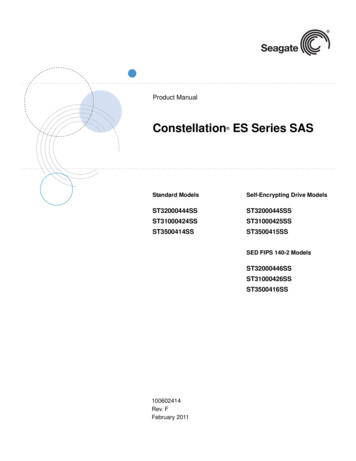
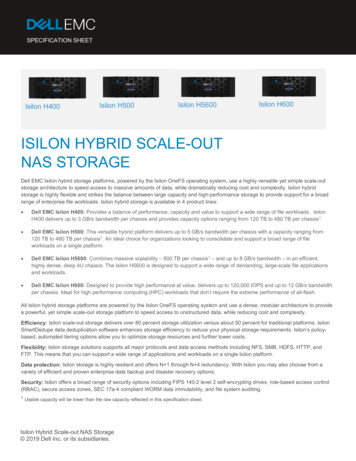
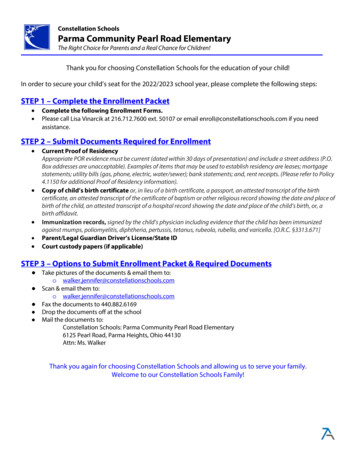
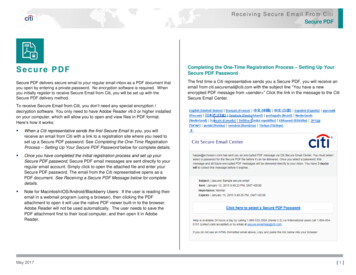




![[MS-EFSR-Diff]: Encrypting File System Remote (EFSRPC) Protocol](/img/29/5bms-efsr-5d-211006-diff.jpg)
